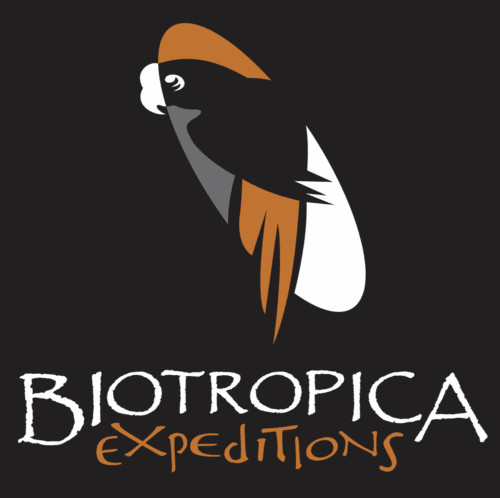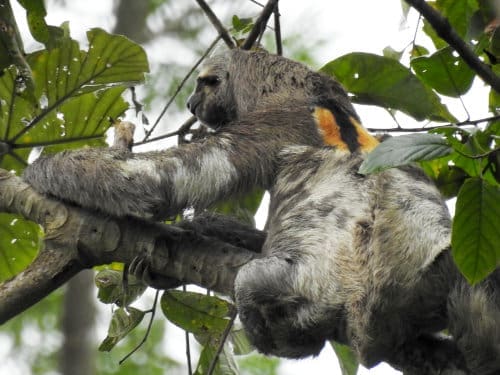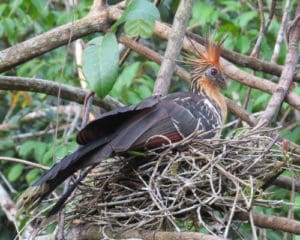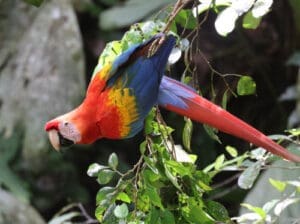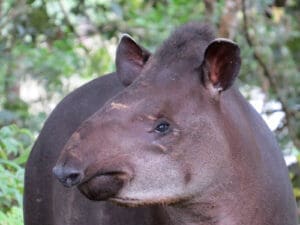Jewels of the Amazon – The Napo Wildlife Center
A Vacation with Positive Social and Environmental Impact5-days / 4-nights OR 8-days / 7-nights
Starting at $3,950 per person / double-occupancy
Yasuni National Park, Ecuador
Jewels of the Amazon – The Napo Wildlife Center
A Vacation with Positive Social and Environmental Impact5-days / 4-nights OR 8-days / 7-nights
Starting at $3,950 per person / double-occupancy
Yasuni National Park, Ecuador
The Yasuni National Park, declared a UNESCO Biosphere Reserve in 1989, covers over 9,800 square kilometers (2 million acres) of pristine Amazon rainforest. It is a true biodiversity hot spot where amphibian, bird, mammal, and vascular plant diversity reach their maximum levels within the Western Hemisphere.
The best way to experience this amazing park is with the Napo Wildlife Center (NWC), one of the very best luxury eco-hotels in Amazonian Ecuador.
This Indigenous-operated ecotourism project includes the conservation of over 53,500 acres of pristine Amazon rain forest, the largest tract of tropical rain forest in Ecuador. This is a small part of the larger whole which includes 2.5 millon acres for the National Park and approximately 2.5 million acres of the Waorani Community Reserve.
Located by the Anangucocha lake, the NWC lies in the ancestral territory of the Añangu Kichwa Community. Thanks to their own initiative and supported by the Ecuadorian EcoEcuador Foundation, the project began as a partnership. Since 2007, the Añangu Kichwa Community own and operate the NWC outright.
At the Napo Wildlife Center, you will experience a show of sounds and colors unlike any you have experienced before.
Please consider adding this trip as an extension to From Andean Peaks to Amazon Rainforests. Also, we are able to add pre- or post-tour options in and around Quito, America’s best-preserved Colonial City.
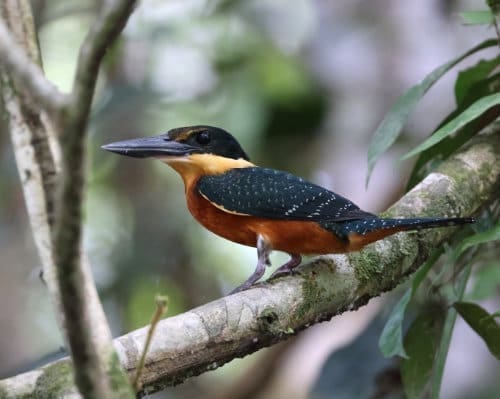
Green-and-rufous Kingfisher | ©Norby Lopez Granda
Day 1 – Arrive in Yasuni National Park
After a hearty breakfast in your hotel, we will head to the Quito International Airport and board a mid-morning, 35-minute flight from to Francisco de Orellana Airport.
Weather permitting, we will have the possibility of seeing many volcanoes as we fly over the Eastern Andes, including Cayambe, located on the Equator. At this point, the land changes from high paramo to vast tropical rain forest extending out from the eastern foothills.
After landing and airport procedures, will take local transport to the boat port, a short trip of about 10 minutes. We will board a comfortable covered motor boat for our trip to the lodge.
A delicious boxed lunch is served during the 2-hour journey. Along the way, we will spot birds like herons, kingfishers, oropendolas, caciques and more.
After landing at Napo Wildlife Center’s entry dock, we will disembark and prepare for the second half of today´s tour, an awe-inspiring and peaceful 1.5 hour dugout canoe ride.
Surrounded by towering trees, we will paddle along a narrow creek that connects to the lake where the lodge is located. In this first outing, we will have excellent chances to observe various species of monkeys and large birds like toucans, parrots or macaws.
We will return in the late afternoon to the overwhelming view of the Añangu Lake in stunning light. The staff will welcome us with a refreshing drink and snack before you are shown to your private cabin.
Before dinner, we will have an introductory presentation about the the Amazon basin, the national park, and the lodge itself. Additionally, each evening we will brief you about our program for the following day.
After dinner, we have an optional night walk where we can observe some of the nocturnal wildlife and listen to the night chorus.
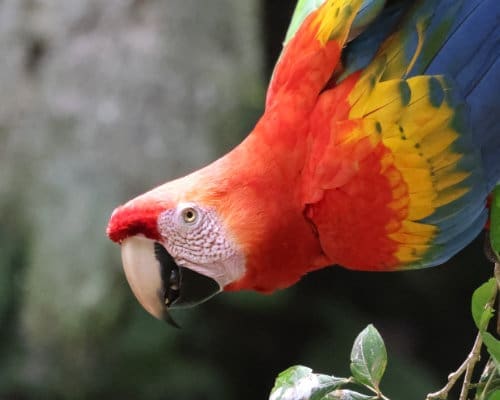
Scarlet Macaw, Napo Wildlife Center | ©Norby Lopez Granda
Day 2 – Parrot Clay Licks and more…
We start our day in rhythm with the Amazon tropical rain forest! An early wake up at 5 am, breakfast at 5:30 am, and departure by 6 am will help us reach the best parrot clay licks in Ecuador.
We will arrive in time for peak parrot activity kicks which kicks off at approximately 7:30 to 8:30 am. A total of 11 species of parrots, parakeets, and macaws visit the lick.
The number and species of birds we observe will dependend on weather conditions. Most days, parrot activity carries on for about an hour or two. Raptors and other predators can show up, making this a dynamic event worthy of a National Geographic program.
Following this extravaganza of birds, we will head towards the forest clay lick. We will hike and explore a well-established trail through terra firme forest for about 20 minutes. With luck and the right weather, we will observe parrots from a well-established bird blind. This clay lick is active between 10 am through 12 pm, approximately. Besides different species of parrots, parakeets, and macaws, this forest clay lick might attract other extraordinary sightings, including mammals.
At the forest clay lick, we have been fortunate to observe and photograph White-lipped and Collared Peccaries, Red-howler Monkeys, Brazilian Tapir, and even Ocelot. Believe it or not, the king of the Amazonian rain forest has visited this clay lick. Yes, we have seen Jaguar here!
We will eat lunch al fresco and spend the afternoon returning to the lodge, exploring along the way. You will have time for relaxing before dinner. After dinner, there will be an optional night walk to observe the nocturnal wildlife and listen to the sounds of nature.

Forest Pit Viper, Napo Wildlife Center | ©Norby Lopez Granda
Day 3 – Forest Canopy Tower and more…
After early breakfast, we depart from the lodge to climb one of the finest towers in the Napo region. At 120 ft (37 m) tall, the 12-story tower provides excellent views into different levels of rain forest.
You will see countless epiphytes, moss, lichen, ferns, bromeliads, Anthurium, Philodendron, and orchids only to emerge at the top of a huge Ceiba – Kapok tree. Here, we have an ample platform to enjoy a view formerly reserved only for birds and monkeys.
Birds that are virtually impossible to see from the forest floor far below are suddenly right beside you, oblivious to your presence. Flocks of colorful tanagers pass right through the canopy. Scarlet Macaws and their Blue-and-yellow cousins fly past; nearby Spider, Howler, Squirrel and Capuchin Monkeys search for food. At least two species of large toucans call in the early mornings and again in the afternoons.
After a morning of wildlife observation, we will return to the lodge for lunch.
In the afternoon, we will tour the lake and creeks by dugout canoe. The lake and creeks provide generous potential sightings.
Our hope is to encounter a Giant otter family! We might also see different species of monkeys which forage different resources for their diet.
All 5 species of Amazonian Kingfishers are present: Ringed, Green-and-rufous, Amazon, Green, and Pygmy Kingfisher.
The diversity of fish species in this Amazonian territory supports herons like Rufescent-tiger, Agami, Boat-billed, Zigzag, and Cocoi.
Amazonian water ecosystems are home to iconic species like the bizarre Hoatzin, the water-loving Anaconda, and four species of caiman. These include the Black caiman, the largest member of the alligator family. It measures over 13 feet (4 meters).
Sunny days also favor groups of Yellow-spotted Turtle, many lying on logs or exposed branches for basking in the afternoon sun.
In the late afternoon, you will have time to visit a different observation tower, one located above the dining room at the lodge. While observing wildlife, you can also enjoy a refreshing drink.
Briefing for our next day activities and dinner at the lodge.
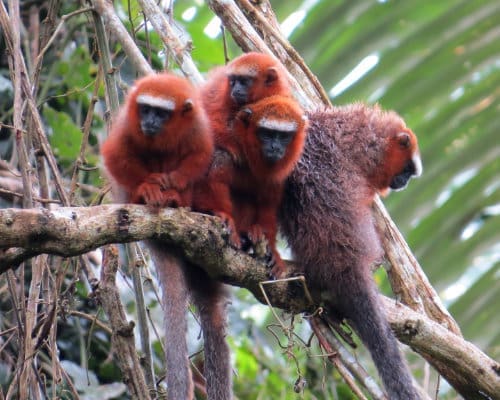
Dusky Tity Monkey, Napo Wildlife Center | ©Norby Lopez Granda
Day 4 – Hiking in the Rainforest and Visiting the Añangu Kichwa Community
Terra firme is habitat that does not get inundated with rain at any time of the year. The ground stays firm despite the season. It is comprised of forest ridges, a universe of lush and well-established canopy. This is part of the Neotropics – new world tropics – one of the most diverse areas of our planet.
This dynamic tropical system will be our excursion in the morning. We will hike along mature forest to discover its interior. We might find lizards, multicolored frogs, colorful manakins, or the unique and endemic Golden-mantled Tamarin Monkeys. Also, we will look out for troops of White-fronted Capuchin, Squirrel monkeys, and Spider monkeys while they cross high in the canopy searching for food.
Our hike will bring us to the Añangu Kichwa Community. The families of the cofounders and leaders of the community live here. Today, this organization has about 180 members, including adults and children. Kury Muyo, an organization of women, will greet us with traditional dances. They will share their rich Amazonian Kichwa culture, through the preparation of different foods and drinks that are part of their diet. We will hear stories about their territory, traditions, and local crops. They will present their handicrafts such as weavings of natural fibers, seeds, and nuts. We will be offered the opportunity to purchase mementos of our visit.
Our visit includes an invitation to enjoy lunch at the community guest house, part of the Napo Cultural Center.
In the afternoon we can visit the canopy tower near the community for more fantastic views of the forests surrounding the Napo River before heading back to the lodge for an quiet evening and dinner.

Giant Otter, Napo Wildlife Center | ©Frank Jordan
Day 5 to Day 8 – Deeper exploration of the Yasuni National Park
If you decide to extend your stay to Day 8, we will enjoy a deeper dive into the surrounding forest, creeks, and streams. The joy of adding time means we have multiple choices on what to add:
- Visit a new clay lick or return to the clay lick we saw before.
- Attempt to the see any bird species that have managed to escape our notice.
- Attend a handicraft workshop.
- Attend a cultural ceremony.
If this is your last day, we will be leaving in the early mroning in order to arrive in time for our flight back to Quito. This means we have a last chance to observe animals along the riverway, like Giant otters and Monk Saki Monkeys. We are guaranteed to see at least a few birds, maybe even a new species to add to our growing list of sightings.
We will arrive in Quito late in the day. We recommend not planning your return flight home on this same evening just in case there are travel delays returning from the Amazon. We can help you arrange to stay at a hotel near the airport for a restful night and flight out the following day.
What To Expect At The Napo Wildlife Center
By traveling with us, you will be part of a private group tour. We will serve as tour leaders and bilingual naturalist guides with extensive knowledge of tropical forest biology, natural history, wildlife, and local cultures. Our group will be led by a native Añangu guide, who is also an official Yasuni Park Ranger.
Additionally, all Añangu guides are experts on the forest’s secrets, and will share with us their ancestral knowledge of medicinal plants and other useful facts about their home. We work in partnership with our Añangu guide, creating informative and enjoyable excursions each day.
It is important to remain flexible in order to take advantage of the highest peaks of activity and weather conditions in the forest. We will schedule our outings as a group before dawn or at sunrise. This will maximize wildlife observation.
We may offer alternative excursions in the late afternoons and evenings to enhance your Amazon experience to the fullest. This is a time when an overwhelming concert of natural sounds will flood the atmosphere.
Let’s get into some details so that you can better understand the wide variety of options available on this tour. Keep in mind, that the shorter tour may not be able to accomodate seeing everything at the NWC.
This Itinerary Includes
- Transfers in and out, from and to airport and lodges.
- Private land transportation according to itinerary.
- Meals and snacks.
- Beverages including purified water, soft drinks, fruit juices, coffee & tea.
- Accommodation based on double occupancy
- Tour Leader - Bilingual Naturalist Guide equipped with quality spotting scope and years of experience.
- Local Indigenous guides at most lodges.
- All excursions described in program.
- Admission fees to parks and reserves described in program.
Not Included
- International airfares.
- Personal expenses like laundry or alcoholic drinks.
- Tips for guides, drivers, and staff.
- Travel or Medical insurance.
- Any other item not specified in what is included.
Important Information for All of Our Tours
Cancelation Policy
Cancellation refunds and penalties are based on the following schedule:
- If cancellation is made 120 days or more before the tour departure date, a cancellation fee of $500 per person will be charged.
- If the client chooses to reserve another Biotropica Expeditions tour that will operate within the upcoming 12 months, the cancellation fee will be $100 per person.
- If cancellation is made fewer than 120 days before departure date, no refund is available.
This policy and fee schedule also apply to all trips or extensions.
We strongly recommend the purchase of trip cancellation insurance for your protection.
Visas and Passports
VISAS:
Visas are not required for U.S., Canadian or European citizens for entry into Ecuador for a stay of up to consecutive 90 days - three months.
PASSPORTS:
You will need a current passport with a minimum of 6 months remaining from its expiration date. We will ask you for this expiration date when you make your reservation.
Your passport will also need a minimum of two blank pages to allow for stamps in and out of Ecuador. If you begin your travel in any other country, be sure to allot more pages for the extra legs of your trip.
Furthermore, ff you need a new or renewed passport, please do so with anticipation. Currently, in the United States, even an expedited passport can take weeks to receive.
We recommend arriving to Ecuador with a color photocopy of the first two pages of your passport. Keep the photocopies in a safe place, so if your passport is lost you will have proof of identification.
The best source for current information about requirements for entering US Citizens entering Ecuador can be found on the US State Department website.
Health and Safety
ECUADOR
The US Centers for Disease Control provides general suggestions for health and vaccinations in regards to your trip to Ecuador. We highly recommend following their suggestions.
The US State Department maintains an updated travel advisory for Ecuador.
We highly recommend our US American clients signing up for the STEP program in order to receive updates from the US Embassy in Quito, Ecuador while traveling.
Additional Expenses
Your trip with Biotropica Expeditions includes most expenses. However, you will want to bring enough cash to cover personal expenses not included in the program. These might include taxi rides, laundry, special gratuities, meals on your own, and gifts to bring home.
It is difficult – if not impossible – to predict fuel costs at the time departure. Our prices are based upon the prevailing fuel rates upon itinerary publication. However, if the fuel rates increase significantly, it may be necessary to institute a fuel surcharge. We will provide as much guidance and warning as possible.
Money in Ecuador
The official currency of Ecuador is the US dollar.
Cash is most commonly used in rural areas and in some family run businesses in cities. We recommend bringing bills in small denominations as anything larger than a $20 can be difficult to spend.
ATM's are available in major cities. However, in smaller towns and rural areas, it can be difficult to find an ATM that works with all international bank cards. When in doubt, carry cash for extra purchases.
Most credit cards, especially MasterCard and VISA, are accepted in many establishments and businesses, especially in large cities like Quito, Cuenca, and Guayaquil.
Pre- and Post- Tours Options
Also, please consider some pre-tour or post-tour options.
Some participants may want to have the option of exploring Quito, the largest and best-preserved colonial center in Latin America, the world's very first UNESCO World Heritage city. With its impressive historical sites, ancient baroque art, museums and cradled in the foothills of Pichincha volcano, participants may choose to arrive earlier and experience a day or two here before beginning the program.
There are many activities in Quito around the colonial center, connecting with museums like the Alabado, which showcases an exquisite array of pre-Columbian ceramics, artifacts in beautiful displays; walking and exploring into numerous striking monasteries and cathedrals; the emblematic Plaza de la Independencia (independence plaza – the main square) from where the expedition that discovered the Amazon river marched to the Atlantic in 1542.
Above Quito is the Pichincha volcano, the gate to the Choco Cloud Forest, the recently added Biosphere Reserve in the Tropical Andes, with extraordinary hiking and birding opportunities, all within the city limits. The views of the imposing Eastern range of the Andes are spectacular.
Other options include the Botanical Garden of Quito with a rich collection and exhibit of native orchids and other species of plants, the Andes mountains in Antisana or Cotopaxi National Parks, exploring the foothills of these superb volcanoes and Paramo ecosystem.
Would you like to personalize Jewels of the Amazon – The Napo Wildlife Center?
Would you like to personalize this tour? Maybe you want to add a day, visit a different site, make sure you see a certain bird? If so, please fill out this form.
If this is an urgent request, contact Norby and Susy directly via WhatsApp at +593 99 901 1505.
